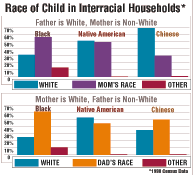Main Menu · Search · Current Issue · Contact · Archives · Centennial · Letters to the Editor · FAQs
![]()
Main Menu ·
Search · Current Issue · Contact · Archives · Centennial · Letters to the Editor · FAQs

| The Multiracial Option | Cortisol Kids | |
| Purging Stereotypes | California Conflicts | |
| E-mail and Web Information | ||

|
Not long ago, after a class on race and ethnicity, a student asked professor of sociology Mary Waters to help her determine her identity. She was from a small town in the rural South, and her mother had told her that she was an American Indian, but not a "real" one, because her ancestors include blacks. She was also part Irish and Scottish. When she applied to colleges, she preferred to check all the boxes that pertained to her identity. Upon arriving at Harvard, she began receiving mail from the Black Students Association. She assumed, therefore, that Harvard had categorized her as "black."
But the young woman's identical twin was also at Harvard. The sister had checked the same boxes on the application forms. She, however, received invitations to meetings of the Native American Students Association. The student wanted to know how identical twins could have different racial identities.
"If any story fits with my analysis of ethnicity and race as social constructions, this one does," Waters says. "This situation was deeply disturbing to the young woman and her sister. It's seen by most people as an absurd problem to be rectified, not a reflection of the reality that multiple ancestries exist among a large proportion of the population in the United States--and that people often choose, or are forced into, only one category for purposes of administrative classification or counting schemes. The story contradicts the assumption that individuals have only one socially meaningful identity."
From 1960 to 1980, the number of interracial couples in the United States rose by 535 percent, to nearly 2 percent of all married couples. Preliminary analysis of the 1990 census shows that the number of racially intermarried couples now constitutes 2.7 percent of the total. Mixed-race children now make up 3.2 percent of births annually.
The intermarriage rate between blacks and whites remains the lowest: only 6 percent of black men and 2 percent of black women marry outside their race. Asians and Hispanics (particularly Cubans) have the highest intermarriage rate with whites, according to Waters. Intermarriage occurs most frequently among those at upper income levels and those with greater educational attainment.
Waters consults with the U.S. Bureau of the Census on how to ask questions dealing with multiracial ancestry or identity. (The bureau has tallied races separately since the first census, in 1790, because the Constitution specified that a slave counted as three-fifths of a white person, and because Indians were not taxed. Race categories on the 1990 census were White, Black or Negro, Indian [American], Eskimo, Aleut, Asian or Pacific Islander, and Other; a separate question asked about Spanish/Hispanic origin.) Waters is also helping the Office of Management and Budget consider a proposal that would create a category for people of multiracial heritage--a category that would affect all federal recordkeeping. Interracial couples and their children are the primary advocates for this proposal, she says, while civil-rights organizations, such as the NAACP and the National Council of La Raza, argue against it.
"It's ironic," Waters comments. "It used to be the archconservatives who wanted to exclude people based on race--one drop of black blood and you were black. The liberals wanted to be inclusive--count every part of your heritage. Now it's all mixed up. Everything's politically driven, due to federal funding for programs and voting districts. Minority groups fear their numbers going down."
 The bars show how respondents designated the race of children in their households. ("Other" indicates a non-standard answer.)CHART BY STEPHEN ANDERSON |
Waters's analysis of the 1980 and 1990 censuses shows enormous change, flux, and inconsistency over the life course of individuals and between generations. "Parents who intermarry tend to simplify the ancestry information they report for their children," she says. "There's a tendency toward 'whitening' and 'darkening.'" In general, 1990 census data on interracial households show that children with one white parent are predominantly classified as white by their parents--with the following exceptions: children with white mothers and Chinese fathers; children with white fathers and Native American mothers; and children with one black parent, who are far more likely to be described as black than as white.
Choice of the "other" race category on the census grew 45 percent from 1980 (6.8 million) to 1990 (9.8 million). Waters speculates that the growth reflects increasing numbers of people of Hispanic origin who marked this option, as well as increasing numbers of mixed race individuals. (Children in households with one black and one white parent were at least five times more likely than other interracial children to be designated "other.") The popularity of "other," and fluctuations in the way individuals answer the ancestry question, convince Waters of the need for a multiracial option. "A multiracial category will have a huge impact," she says. "It will start people thinking about themselves as multiracial."
~ M. Elaine Mar
Main Menu ·
Search · Current Issue · Contact · Archives · Centennial · Letters to the Editor · FAQs
![]()